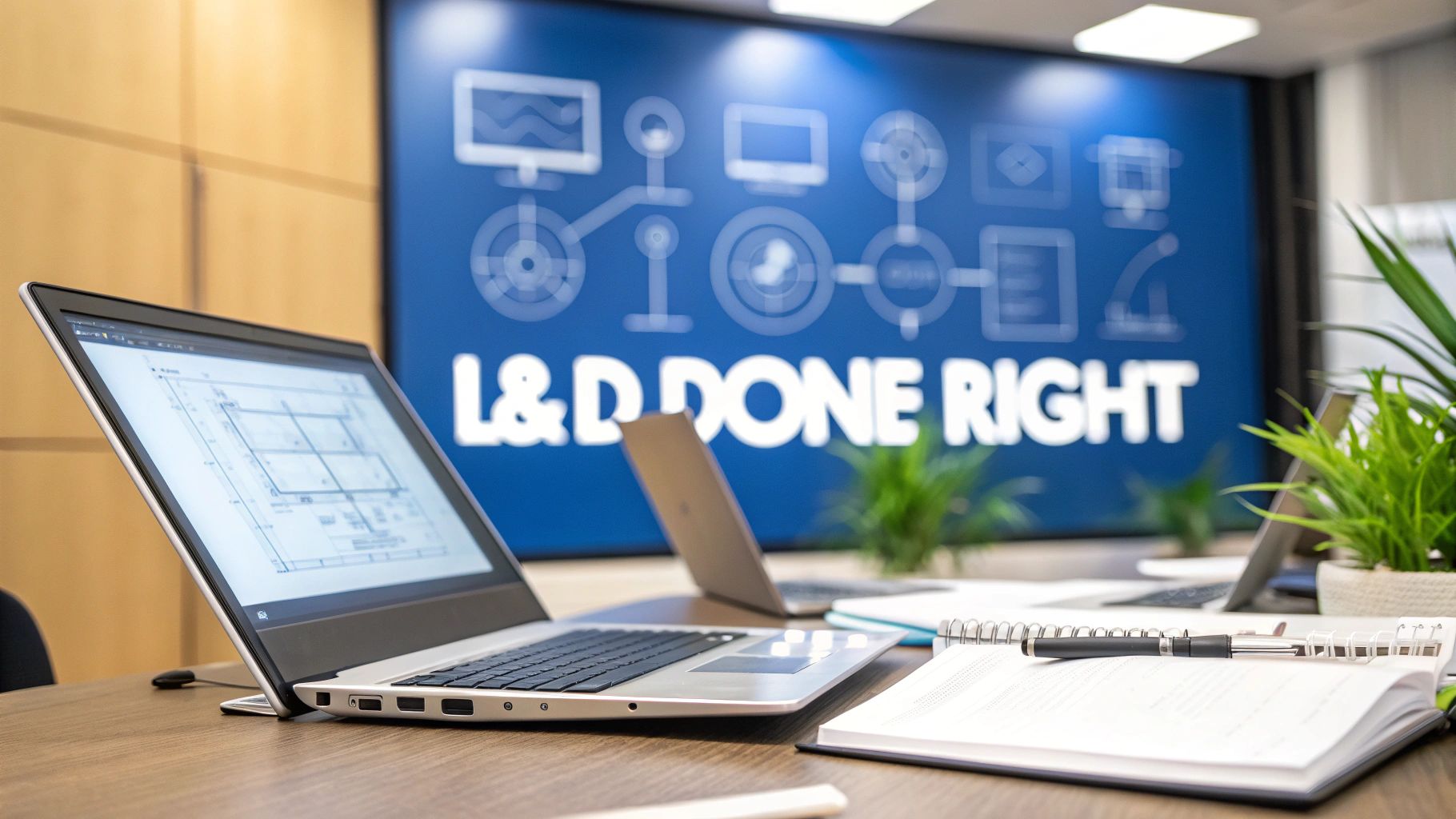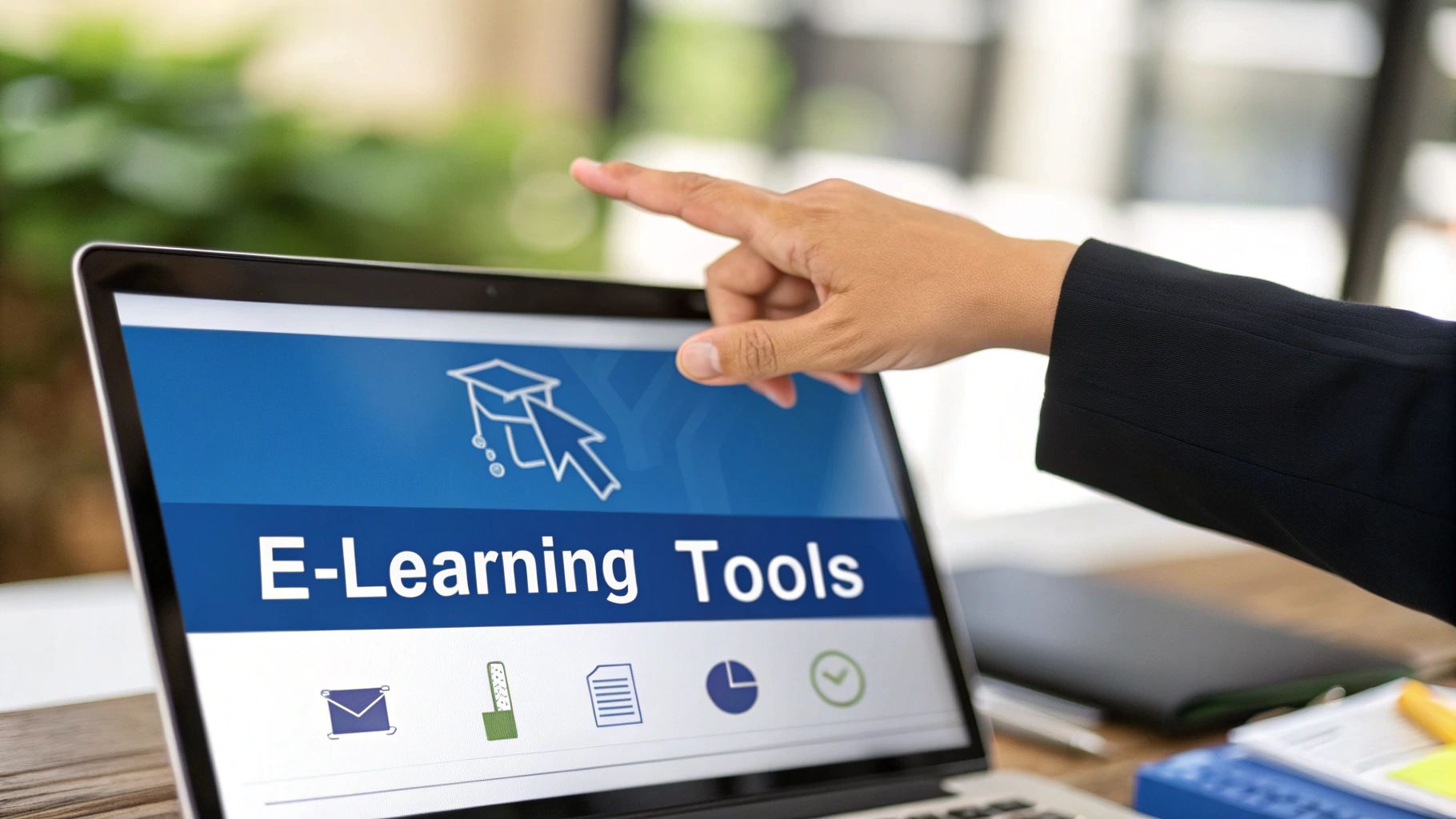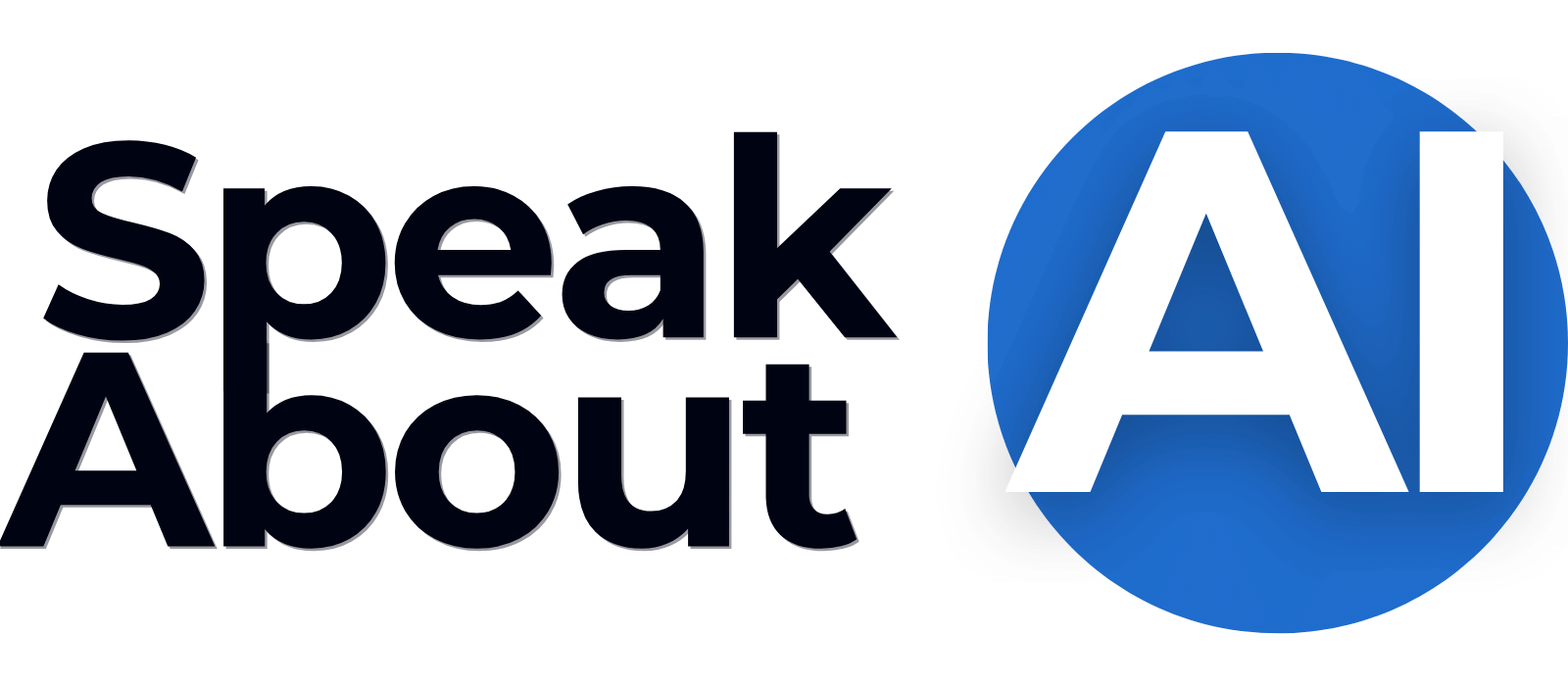Corporate Learning and Development Done Right

Let's be honest, "corporate learning and development" used to conjure up images of stale donuts, mandatory compliance videos, and stuffy conference rooms. That world is long gone.
Today, corporate L&D is the strategic engine that separates thriving companies from the ones left behind. It's not about a few training sessions; it's a constant, deliberate effort to grow your people's skills in a way that directly fuels your company's biggest goals.
Why Modern Corporate Learning Is a Business Imperative

In today's hyper-competitive world, L&D has graduated from a simple HR function to a critical business driver. The most successful companies get it: their growth is tied directly to the growth of their people. It's that simple.
Think of it this way: your business strategy is the destination you want to reach. Your L&D program is the sophisticated navigation system that gets your team there, equipped for any detours or roadblocks. Without it, you're just hoping you'll end up in the right place, risking stagnation, losing your best people, and watching competitors fly by.
Adapting to a New Work Reality
The game has changed. Digital workflows, remote teams, and rapidly evolving tech have made continuous learning a non-negotiable part of doing business. The skills that were essential five years ago might be collecting dust today, and entirely new roles are popping up faster than we can write job descriptions for them.
A proactive approach to L&D is your company's immune system against irrelevance.
Our expert speakers on organizational change, for instance, emphasize that adaptability is the new currency. A strong learning culture empowers your employees to pivot on a dime, master new tools, and solve complex problems. This is how you build a resilient, forward-thinking organization.
The Strategic Edge of Continuous Development
A genuine commitment to helping your team grow pays for itself over and over again. It creates a powerful feedback loop: skilled, confident employees drive better business results, which in turn justifies even more investment in their development. This is the cycle that fuels sustained success.
A well-executed L&D strategy does more than just fill skill gaps. It builds a culture where curiosity is encouraged, innovation thrives, and employees feel valued enough to build a long-term career.
Many of our speakers on leadership and performance management drive this point home. They offer practical frameworks for weaving L&D into the very fabric of your business strategy, not treating it like some separate, optional extra.
The benefits are clear and measurable:
- Enhanced Employee Retention: It's no secret that people want to grow. In fact, a staggering 94% of employees say they would stay at a company longer if it invested in their learning.
- Improved Innovation: A workforce that's constantly learning is better equipped to spot new opportunities, challenge the status quo, and come up with game-changing ideas.
- Increased Agility: Continuous learning builds an organization that can react to market shifts, new technology, and changing customer needs with confidence, not fear.
Designing a High-Impact L&D Framework
Creating an L&D program that actually moves the needle isn't about just throwing a course catalog at your employees and hoping something sticks. A truly effective program requires a deliberate, strategic framework—one that connects every learning activity directly back to what the business needs to achieve.
Think of it like building a custom race car, not just buying a sedan off the lot. Every single component is chosen to meet a specific performance goal.
The entire process kicks off with a thorough needs analysis. This is the most critical first step. It means sitting down with department heads and leadership to get a crystal-clear picture of their biggest challenges and strategic objectives.
Are you trying to boost sales productivity? Cut down customer support resolution times? Or maybe you need to groom your next generation of leaders from the mid-management ranks. You can't map the route until you know the destination.
Structuring Learning With The 70-20-10 Model
Once you've identified the mission-critical skills, you can start structuring the learning experience. One of the most balanced and proven approaches out there is the 70-20-10 model. It's a simple yet incredibly powerful recipe for well-rounded development.
This model is built on the idea that real learning happens in different ways:
- 70% Experiential Learning: This is learning by doing. The vast majority of professional growth happens right on the job—tackling new projects, solving real-world problems, and getting your hands dirty.
- 20% Social Learning: This piece of the puzzle comes from interacting with others. Think mentorship programs, coaching from managers, peer-to-peer feedback sessions, and collaborative work. It's learning through observation and dialogue.
- 10% Formal Learning: This is the most traditional component, covering structured courses, workshops, webinars, and eLearning modules. While it’s the smallest slice of the pie, it provides the essential foundational knowledge that everything else is built upon.
Following this framework ensures learning isn't a one-and-done event but a continuous process woven directly into the daily workflow. It prioritizes practical application, which is where true skill mastery really happens.
To help you decide which framework best suits your organization's culture and goals, here’s a quick comparison of some popular models.
Comparing Popular L&D Framework Models
| Framework Model | Core Principle | Best For |
|---|---|---|
| 70-20-10 Model | Blends on-the-job experience (70%), social interaction (20%), and formal training (10%). | Organizations aiming for holistic, integrated learning that mirrors real-world workflows. |
| ADDIE Model | A sequential process: Analysis, Design, Development, Implementation, Evaluation. | Structured, large-scale projects where consistency and thorough documentation are critical. |
| Kirkpatrick's Four Levels of Evaluation | Measures training effectiveness across four levels: Reaction, Learning, Behavior, and Results. | Teams focused on proving the ROI of L&D by linking training directly to business outcomes. |
| Agile Learning | Breaks down learning into short, iterative cycles, allowing for rapid feedback and adaptation. | Fast-paced environments where skills needs change quickly and flexibility is key. |
Each of these models offers a different lens through which to view learning. The key is to pick the one that aligns most closely with your company's immediate needs and long-term vision.
Building Your Program With Key Learning Components
With a model like 70-20-10 as your guide, you can start plugging in the specific components of your L&D initiative. This is where you can bring in experts to deliver targeted, high-impact knowledge. Our roster of keynote speakers offers deep insights that can supercharge the formal learning portion of your framework, covering everything from AI integration to leadership psychology. Finding the right voice can set the tone for the entire program.
Digital tools have made delivering these components easier and more scalable than ever. By 2023, a staggering 98% of corporations planned to use eLearning, largely driven by the need to close skill gaps—a top priority for 61% of L&D professionals. The corporate eLearning market is on track to hit $462.6 billion by 2027, cementing its role as a cornerstone of modern workforce strategy. You can discover more about these corporate eLearning trends on Continu.com.
The metrics below highlight the real, tangible impact that a well-structured training program can have.
This data shows a clear and powerful link between investing in training and achieving positive business outcomes, from stronger performance to higher employee satisfaction.
Securing Leadership And Manager Buy-In
A brilliant framework is useless without support. Gaining buy-in from the C-suite and—just as critically—from front-line managers is absolutely essential for your program to succeed. After all, managers are the gatekeepers of the "70%"; they're the ones assigning stretch projects and providing that crucial real-time coaching.
To get them on board, you have to speak their language. Don't frame L&D as a cost center. Frame it as a solution to their biggest headaches.
Show them exactly how a specific training program will directly impact their team's KPIs—whether that’s hitting sales targets, improving product quality, or reducing employee turnover. Present a clear business case with expected, measurable outcomes.
When leaders see L&D as a strategic partner in hitting business goals, they become champions. They'll find the resources, protect the budget, and encourage their teams to dive in. This alignment is what transforms training from a "nice-to-have" into a core part of the company's operational rhythm.
For more ideas on structuring these initiatives, check out our services and see how expert speakers can anchor your L&D events.
Connecting Employee Growth to Business Results

Investing in corporate learning and development isn't just a perk; it's one of the sharpest business strategies out there, paying dividends you can actually measure. The smartest leaders get it: pouring resources into employee growth isn't an expense, it's a direct investment in the company's future.
When you draw a clear line between developing your team and hitting your goals, you create an undeniable link between a skilled, motivated workforce and a healthier bottom line.
Think about it. When employees see a real path to grow their skills and advance their careers right where they are, their engagement goes through the roof. This isn't just a nice-to-have. It translates directly into higher productivity, better quality work, and a major drop in employee turnover. The logic is simple: people who feel invested in are far more likely to invest their talent and energy right back into the company.
From Cost Center to Profit Driver
For far too long, L&D was seen as just another operational expense—a line item on the budget that was often the first to get slashed in tough times. That whole perspective is outdated and, frankly, damaging.
Today, a strong corporate learning program is a critical profit driver. It’s the engine that turns the entire function from a simple cost into a strategic asset for growth.
Consider the sky-high cost of recruiting, hiring, and onboarding someone new. Upskilling the team you already have is one of the most cost-effective growth strategies available. You keep all that valuable institutional knowledge, slash recruitment expenses, and build a more loyal, capable workforce—all at once. It's a win-win that directly pads your profitability.
"When you make employee growth the cornerstone of your culture, you're not just training people—you're building a more resilient, innovative, and competitive organization from the inside out."
This shift in mindset is everything. It’s about finally recognizing that your people are your most valuable appreciating asset. By nurturing their skills, you build a sustainable competitive advantage that others simply can't copy.
The Speaker Perspective on Culture and Growth
To bake this philosophy into your company's DNA, bringing in an expert voice can connect the dots between culture and results. The organizational culture speakers on our roster are masters at this, using real-world examples to show leadership teams how a culture of continuous learning directly fuels business performance.
These experts can energize your people and provide actionable frameworks for making L&D a core part of your company. They help leaders see that every dollar spent on training is an investment in future innovation and market leadership. The right speaker can kickstart this cultural shift, making the business case for L&D in a way that clicks with everyone in the organization. If you need some ideas on finding the perfect fit, you can explore our guide on ensuring a successful online event with a virtual keynote speaker.
Quantifying the Impact of L&D
The data backs this up in a big way. Organizations with strong learning cultures aren't just better places to work; they're more profitable and productive, period. The evidence shows a straight line between formalized training and real business outcomes.
For example, companies that truly prioritize robust training programs see a remarkable 218% higher income per employee compared to those that don't. That financial boost is paired with a massive surge in loyalty, with around 80% of employees saying they would stick with a company longer if it invested in their training.
With the global workplace training market hitting $401 billion in 2024, it’s obvious that top companies are doubling down on this strategy for a reason. This proves that corporate L&D is so much more than a "feel-good" initiative. It's a calculated, strategic investment with a clear and compelling return that touches everything from revenue and retention to innovation and resilience.
Using AI and Technology to Personalize Learning
Technology has completely upended corporate learning and development. The old one-size-fits-all model of generic seminars and dusty training manuals is finally giving way to smart, dynamic systems built around the individual needs of each employee.
Leading this charge is Artificial Intelligence. AI is making learning at work more personal, efficient, and genuinely engaging than ever before. It’s about more than just delivering courses; it’s about creating a truly adaptive learning environment.
Think about how Netflix learns what you like and recommends shows you'll probably binge-watch. AI-powered learning platforms do the same for professional development. They look at an employee’s role, existing skills, performance data, and even career goals to build a unique learning path just for them.
So, a junior software developer might get suggestions for advanced coding modules, while a newly promoted manager is served content on effective leadership. This kind of personalization makes sure training is always relevant and immediately useful.
Navigating the Modern Learning Tech Stack
The tools available for corporate learning are more sophisticated than ever. Two platforms you’ll hear about constantly are the Learning Management System (LMS) and the Learning Experience Platform (LXP). They sound similar, but they do very different jobs.
An LMS is your classic top-down system. It's the workhorse for administering, tracking, and reporting on mandatory training and compliance courses. Think of it as the system of record—it makes sure everyone completes what’s required.
An LXP, on the other hand, is a bottom-up, learner-first platform. It functions more like a curated marketplace, pulling in articles, videos, podcasts, and courses from all over. It lets employees discover and chase down learning that lines up with their personal interests, which helps build a culture of curiosity.
The smartest L&D strategies today blend the structured world of an LMS with the personalized discovery of an LXP. This creates a balanced ecosystem that serves both the company’s needs and the individual’s drive to grow.
The Speaker Perspective on Choosing the Right Tools
Bringing in new tech can feel overwhelming. The secret is to pick tools that create truly impactful learning experiences, not just tools that automate old, broken processes. This is where a leading speaker on technology and future trends from our roster can be a game-changer.
An expert can help you slice through the marketing fluff and focus on what actually works. They can show you how to assess your organization's real needs, choose the right tech, and weave it into your existing workflow. Even better, they inspire leaders to think bigger—to see how technology can fundamentally improve how people learn and grow at work. For those wanting to see how AI is being used in similar professional fields, exploring a curated list of AI tools for event planners can offer some great insights.
Immersive Technologies Creating New Realities
Beyond AI platforms, other technologies are making training more hands-on and effective. Immersive tech like Augmented Reality (AR) and Virtual Reality (VR) isn't just for sci-fi movies anymore; it's a powerful tool for corporate L&D.
These technologies create safe, controlled sandboxes for hands-on training that would be too dangerous, expensive, or disruptive in the real world. Just look at the possibilities:
- Surgeons can practice complex procedures in a zero-risk virtual operating room.
- Engineers can learn to fix heavy machinery without ever shutting down a production line.
- Customer service reps can practice handling tough conversations with AI-powered avatars.
This kind of experiential learning builds muscle memory and real confidence in a way a textbook never could. It closes the gap between knowing about something and knowing how to do it. By carefully choosing and integrating these powerful tools, you can build a corporate learning program that isn't just personalized, but deeply impactful and ready for whatever comes next.
How to Measure the ROI of Your L&D Programs

So, you've invested in a killer corporate L&D program. How do you actually prove it's paying off? In a world driven by data, showing a clear return on investment (ROI) is non-negotiable. It's how you secure budgets, earn a seat at the table, and prove the strategic value of what you do.
It’s time to move past the easy stuff. Course completion rates and "smile sheets" are simple to track, but they tell you almost nothing about whether the training actually worked. Did it change behavior? Did it improve performance? Did it move the needle on a real business goal? Those are the questions that matter.
Answering them requires a more structured game plan. One of the most trusted frameworks in the industry for this is the Kirkpatrick Model, which gives you a clear roadmap to evaluate training effectiveness across four distinct levels.
The Four Levels of the Kirkpatrick Model
The Kirkpatrick Model is brilliant because it walks you through the entire journey of impact, starting with gut reactions and ending with tangible business results. Each level builds on the one before it, painting a complete picture of your program’s real value.
A classic rookie mistake is stopping at Level 1. To truly prove ROI, you have to connect the dots all the way to Level 4, where learning is directly tied to business outcomes.
Here’s how the four levels break down:
- Level 1 Reaction: This is the immediate feedback. How did people feel about the training? Was it engaging? Relevant? Well-delivered? You'll typically grab this info with post-training surveys.
- Level 2 Learning: This level checks if they actually learned anything. Did they absorb the knowledge, skills, and attitudes you were teaching? You can measure this with quizzes, skills tests, or simple pre-and-post assessments.
- Level 3 Behavior: This is where the rubber meets the road. Are people applying what they learned back on the job? This requires a bit more digging, often through manager observations, 360-degree feedback, or performance reviews.
- Level 4 Results: This is the ultimate proof. Did the training have a direct, positive impact on the business? Here, you're tracking the specific business KPIs the training was designed to influence in the first place.
This table gives you a practical look at how to apply the model.
Evaluating Training with the Kirkpatrick Model
The Kirkpatrick Model provides a straightforward way to measure the impact of your programs at each stage.
| Level | What It Measures | Example Metric |
|---|---|---|
| Reaction | Participant satisfaction with the training experience. | An average satisfaction score of 4.5 out of 5 from post-training surveys. |
| Learning | The increase in knowledge or skill acquisition. | A 30% improvement in scores on a post-training knowledge assessment. |
| Behavior | The extent to which learned skills are applied on the job. | A manager report showing a 20% increase in the use of new sales techniques. |
| Results | The tangible impact on key business indicators (KPIs). | A 15% decrease in customer support tickets following a service training program. |
By moving through all four levels, you create a powerful, data-backed narrative about your L&D program's effectiveness.
Connecting Learning to Business KPIs
The final—and most important—step is tying your learning outcomes directly to the metrics that leadership actually cares about. This is how you stop being a "cost center" and start being a strategic partner.
Let's say you roll out a new project management training program. Forget just tracking how many people finished the course. Instead, track KPIs like the percentage of projects completed on time and on budget in the months that follow.
If your sales team gets new negotiation training, the metric that matters isn't their test scores—it's the average deal size or the sales cycle length in the next quarter. That direct line from training to results is what makes the value of L&D undeniable.
Future-Proofing Your Workforce for What's Next
The ground is constantly shifting, and the skills that are critical today might be obsolete tomorrow. To get ahead—and stay there—companies have to stop training for yesterday's problems. The focus needs to shift from filling current gaps to proactively building a workforce that can handle whatever comes next. It’s about creating agility from the ground up.
This proactive mindset relies on two key strategies: upskilling and reskilling. They sound similar, but knowing the difference is crucial for building a team that can pivot on a dime.
- Upskilling is about making your people better at what they already do. Think of a data analyst learning advanced machine learning techniques to go deeper into their current role. It's about adding layers to existing expertise.
- Reskilling, on the other hand, is about training someone for a completely new role. This could be a factory worker learning to maintain the robots that are automating the assembly line. It’s about building a bridge to a new function.
When you use both, you can close skill gaps before they turn into full-blown crises. You keep your best people, hold onto valuable institutional knowledge, and still adapt to whatever the market throws at you.
Prioritizing Durable Human Skills
As AI and automation start handling more of the routine, technical stuff, the skills that truly matter are the ones that are uniquely human. These are the durable, transferable abilities that a machine just can't replicate. The futurist speakers on our roster all agree: the next decade belongs to companies that cultivate these core human competencies.
In an era of intelligent machines, the premium is on human ingenuity. Skills like creativity, collaboration, and critical thinking are no longer 'soft skills'—they are essential drivers of innovation and competitive advantage.
This is exactly why investing in targeted learning programs pays off big. A workshop on creative problem-solving or a coaching program on emotional intelligence gives your team the toolkit to navigate messy, unpredictable challenges. These aren't just nice-to-haves; they're the bedrock of a future-ready workforce.
The Speaker Perspective on Future Skills
If you want to know what’s coming, listen to the people who study the future for a living. The futurist speakers on our platform cut through the noise to offer a clear roadmap of the skills that will be in high demand. They don’t just throw around buzzwords; they show you what your team needs to be learning right now to thrive tomorrow.
They consistently point to skills like:
- Cognitive Flexibility: The ability to pivot your thinking on the fly and adapt your approach when new information comes in.
- Complex Problem-Solving: The knack for tackling tangled, multi-layered problems that don’t have a clear instruction manual.
- Adaptability and Resilience: The mental toughness to navigate constant uncertainty and bounce back from setbacks without losing steam.
Bringing an expert on future trends to your next L&D event does more than just inform—it inspires a culture of continuous learning. They provide the "why" that gets everyone, from the C-suite to the front lines, genuinely excited about building the skills for what’s next.
Common Questions About Corporate L&D
As corporate learning and development keeps changing, a few key questions pop up again and again. Getting these right is the difference between a program that looks good on paper and one that actually delivers on the ground.
Let’s tackle some of the most common challenges with straightforward, practical answers.
How Do You Engage a Remote Workforce in L&D?
Engaging remote teams isn’t about just putting training online; it's a complete shift in thinking. Success comes from making learning accessible, flexible, and surprisingly communal, even when your people are spread across time zones.
The best approach is a hybrid one. Mix live, virtual instructor-led training (VILT) for that collaborative, in-the-room energy with self-paced microlearning modules people can tackle on their own schedule. Our speakers who specialize in remote work culture always stress creating digital "water cooler" moments—think dedicated Slack channels or internal forums where people can chat about what they're learning.
A little friendly competition never hurts, either. Things like digital badges for completing a course or team-based leaderboards can really spark motivation. The non-negotiable? Everything must be mobile-friendly and dead simple to access. Meet your team where they are.
How Can Small Businesses Implement L&D on a Budget?
A tight budget doesn't mean you have to put employee growth on the back burner. Small businesses can build fantastic L&D programs by being scrappy and focusing on high-impact, low-cost moves.
Start by curating the wealth of high-quality free content out there. Platforms like YouTube, Coursera, and industry blogs are gold mines. Many of our speakers share incredible insights in free webinars and articles that can form a solid foundation for your curriculum.
The most powerful, budget-friendly tool is often sitting right in your office: your own people. A formal mentorship program pairing seasoned pros with junior team members costs nothing but time and is priceless for transferring institutional knowledge.
You can also use free tools like Google Forms to handle post-training surveys and quizzes. The key is to start small. Identify the one or two most critical skill gaps in your company and focus all your energy there. When you show a clear, measurable win on a small scale, you'll build a rock-solid case for more investment down the line.
What Is the Best Way to Kickstart a New L&D Program?
Launching a new L&D initiative needs a spark. The best way to get one is with a compelling kickoff event that generates real excitement and gets everyone on board from day one. Bringing in a keynote speaker can set the perfect tone, framing the program not as another mandatory task, but as a genuine opportunity for personal and professional growth.
A great speaker connects the "why" behind the training directly to the company's vision and each person's career path. That initial spark is what builds momentum and turns passive employees into active, enthusiastic participants.
At Speak About AI, we connect you with the industry's leading experts who can anchor your L&D initiatives and inspire your teams. Explore our roster to find the perfect voice to launch your next program. Find your speaker on speakabout.ai.
